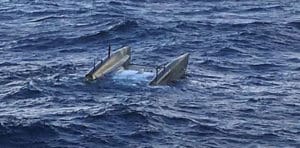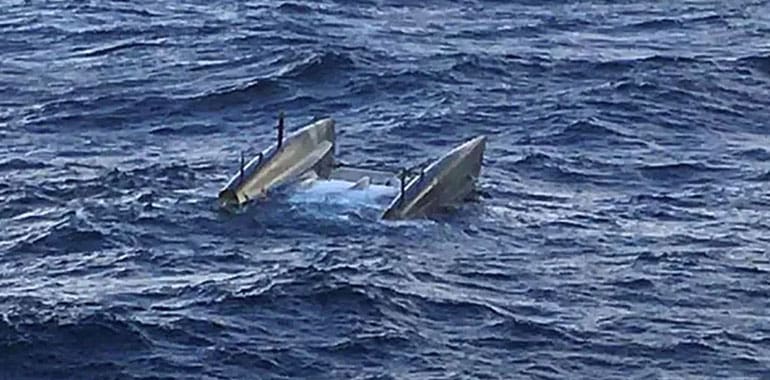
On November 9, the 328-foot Finnish-flagged cargo ship Midas rescued three French sailors from the capsized 50-foot catamaran Hallucine in the Atlantic Ocean off the coast of Portugal. Included among the rescued sailors was French racer Regis Guillemot. A fourth crewman drowned when he was thrown overboard by the capsize. His body was recovered 36 hours after the rescue. Portuguese search-and-rescue authorities directed Midas to change course and rescue the three sailors, who reportedly spent one night on the overturned cruising cat before shifting to a life raft.
Midas had left Riga, Latvia, and was en route to Florida when it was given the rescue mission. At 4:30 p.m. on Saturday, UTC time, the Lisbon Maritime Rescue Center called Midas via satellite phone. What follows is the account of the captain of Midas, Timo Väänänen.
“They said that 50 nautical miles east of us, a distress signal from the pleasure boat had been detected. But no contact had been made with the boat since then, so there was no information about the quality of the distress [situation]. Midas was the closest ship at the moment. We changed course and it took us about four hours to get to the location [of the catamaran].
“At the same time, a Portuguese Coast Guard plane arrived. Detection was successful thanks to a location signal. The plane circled low, looking for potential people in the ocean. We saw a large catamaran lying upside down and a small life raft near it.
“Seas were so high that Midas’ man overboard gear could not be lowered. Also, the freefall lifeboat could not be lowered because we would not have been able to lift it back into position. We then did the trick with the sea and the wind [making a lee] so that we could drive the ship as close as I dared to the life raft. Then we used a rocket device that fired an explosive charge that sends a thin string up to a couple of hundred yards away. It’s hard to get it going in the right direction in the wind, but we managed to get it pretty close to the life raft.
“The first shot was successful, but for safety we fired a second shot. The survivors then paddled along the rope with their last strength and only one paddle. The landing bridge was lowered, and the survivors ascended to Midas. They were barefoot, had been in a small life raft for eight hours.
“Their mood was very contradictory, relief from salvation, of course, but grief about the loss of their friend. Late Saturday night, the Portuguese maritime rescue authorities found the body at sea. I had to show the rescued men a picture of the drowned man sent by the authorities, from which they identified their comrade. It was very tragic.
“They were very experienced ocean sailors on their way from France to Gran Canaria, from where the journey was to continue later to the Caribbean. The crashed catamaran has participated in major sailing competitions and has crossed the Atlantic many times.
“I’ve been skippering cargo ships on the world’s seas for 17 years. This is the first time I have been in such a situation. There was a challenge, but with the help of a good crew and good cooperation, we succeeded.”
Via Boatwatch.org

